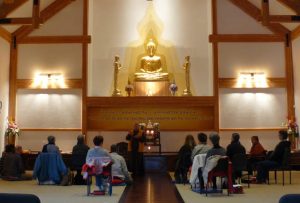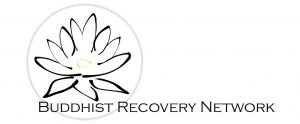By Paul Saintilan – 
A significant number of people in recovery refer to the similarities between their new drug- and alcohol-free lifestyle and that of Buddhism. Can understanding one help us to understand the other? Paul Saintilan sheds light on compelling comparisons – and offers an alternative for those who have rejected the 12 steps.
Buddhism is almost exclusively concerned with the development of the individual, of improving ourselves by focusing on the mind, which makes it very suitable for people intent on fighting and winning the greatest of all battles: the battle with self. And its ideals of purity, clarity, tranquility and simplicity are attractive to people recovering from addictive, chaotic lifestyles.
I am a practicing Buddhist with Friends of the Western Buddhist Order, in recovery for almost three years, and founder of the Buddhist Recovery Network website, which features a literature review of Buddhist recovery titles – there are at least 10 books which compare and contrast the Buddhist ‘path to freedom’ from addiction with the 12-step recovery tradition.
In comparing a 12-step approach with Buddhism, we first need to recognize that we are already taking liberties by implying that ‘Buddhism’ is one approach or practice. There are different interpretations and emphases but the points I raise in this article will be generally held across different schools.
Let us first look at compelling similarities, which immediately make clear why so many people have been drawn to the topic…
- Both traditions were borne out of hopelessness and suffering, an intense quest for a solution, pursued despite setbacks; through ‘ego-deflation’, a solution was discovered, then that discovery shared.
- The Buddha’s ‘four noble truths’ on which the entire Buddhist edifice is built, and which are intrinsic to the 12 steps, are about accepting the truth of suffering, that suffering is caused by craving and that there is a solution. Both traditions understand the significance of denial. Just as humans are in denial of their true craving nature, denial is a symptom of chemical dependency.
- The AA programs’ 11th step encourages the pursuit of meditation, and meditative practice is at the core of Buddhism’s path of inner transformation.
- Buddhism emphasizes the heightening of awareness as opposed to intoxicated states, which are singled out to be avoided in the fifth ‘lay’ precept of ethical conduct.
- Both emphasize the importance of actively working with people to alleviate their suffering, as an essential part of each person’s development; in the 12 steps, it is termed “12th-step work”, in Mahayana Buddhism “the Bodhisattva ideal”.
- Both agree that the basic solution to freedom from craving is not to be found down avenues such as pharmacological intervention (though short-term medication may be necessary for some people). The solution is ultimately a ‘spiritual’ one, starting with accepting that there is a problem. The path to freedom is then a process of letting go, an ongoing process of forgiveness, acceptance and surrender, rather than tightly holding on in fear to old supports and illusions. We need to ‘give up hope of a better past’ and stop trying to control things over which we have no control. We need to let go of many things: our illusions and delusions, certain self-images and aspects of our identity, compulsions, habits and behaviors, even some (drinking) friends and acquaintances.
- The 12 steps and Buddhism, particularly Taoism, share an element of paradox. This is nicely conveyed in the following verse from Lao Tzu’s Tao Te Ching: “Yield and overcome. Bend and be straight. Empty and be full. Wear out and be new. Have little and gain. Have much and be confused” (also quoted in Jim McGregor’s The Tao of Recovery).
- Both traditions look at craving and addiction in a far deeper way than merely a simple craving for our drug of choice; they look at the craving beneath the craving. To have the richest sense of craving from a buddhist perspective, we are also talking about ‘existential’ craving, a pervading sense of anxiety which can result from the search for meaning, or a sense of lack or something missing. In the 12 steps also, the focus is to look deeper at our inner emotional landscape and the ways in which guilt, jealousy or other emotions might be driving our behavior.
- In Buddhism and recovery, our egoistic self is not considered the deepest and most profound part of ourselves. The degree to which we totally focus on our egos and desires is the degree to which we constrict our world view, and chain ourselves to our woes. In recovery, we try to reach our “higher consciousness” or “higher power”; in Zen Buddhism, it is called our “Buddha nature” or “original mind”. Through meditation we aim to access this part of ourselves.
- It is well known to Buddhists and people in recovery that intellectual understanding alone is insufficient to motivate change. We need to move from understanding to conviction, achievable through experience. Smokers, for example, know that smoking causes them harm, yet sometimes the compulsion to smoke is irresistible. The language of the 12 steps, involving being “humble”, “willing” or “praying”, is not the language of intellectual analysis but of emotional commitment. Buddhism tries to engage the heart as well as the head. When the heart is engaged, we can find the motivation to transform ourselves through action. Buddhist ritual and devotional practices are undertaken for precisely this reason: to engage the heart.
- We can draw comparisons between Buddhism’s “three jewels” and aspects of the 12 steps. Author Bill Alexander wrote in Cool Water (see references at end of this article) that: “I consider the Buddha here to be that greater self that I am an expression of when I am living fully in the moment and in consonance with the 12 steps and my Buddhist vows. It is the 12 steps and the vows that, in this context, are the dharma, while the sangha is my own chosen community”. I have heard this summarized as: Buddha = higher power, Dharma = program, and Sangha = fellowship.
These points touch only briefly on rich areas of exploration. But it is also important to draw out points of difference, and problems which could arise when people new to recovery set off to explore Buddhism. It is well placed to help people who have rejected the 12 steps because they cannot relate to the predominantly theistic language printed 70 years ago in the book of Alcoholics Anonymous and still used today.
It is correct to point out that AA terms like ‘higher power’ or ‘God-as-you-understand-him’ are chosen to allow the widest number of interpretations. But, while this is technically correct, the predominantly Christian interpretations shared during 12-step meetings plus the Christian tone of much of the literature do alienate some people. Buddhism can help some of these people who do not have a belief in God and feel alienated from AA and other 12-step groups.
ForB in AA, the interpretations of higher power are many and varied. For Kevin Griffin (see references), it has been “a vast, subtle energy pervading all things – a great spirit”. For others, it is “mindfulness” or their teacher and tradition. For those in the Zen tradition, it can be your ‘original mind’ or ‘Buddha nature’.
There is also a difference worth noting in the character of western Buddhist sanghas and recovery groups. As Griffin points out in One Breath At A Time, people in 12-step groups “share a bond forged in pain, struggle and eventual redemption”. Buddhist groups, in contrast, are filled with people striving for perfection, perhaps even a trifle competitively.
“So, although the Buddhist teachings emphasize compassion and interconnectedness, in many Buddhist communities we have not found ways to bring the kind of immediate bonding that newcomers to the 12 steps can feel after their first meeting when they are surrounded by people offering their phone numbers and asking how they can help.”
Another point is that, in a recovery group, you are surrounded by people who know something about addiction through first-hand experience. This will not be the case in most Buddhist sanghas, and can lead to some issues.
For example, AA believes that “once an alcoholic, always an alcoholic” and technical advances in neuroscience have been consolidating this view since 1990, reaffirming the concept that alcoholic/addictive behavior is triggered by an artificial chemical such as alcohol which reacts with particular naturally-occurring brain chemicals, and can be avoided only by being abstinent from that chemical/drug of choice. But many Buddhists who know nothing of the 12 steps are instinctively suspicious of assertions along these lines. This is for two reasons.
The first is that Buddhism has a dynamic view of the world, emphasizing process and change, a perspective which is inspiring when applied to recovery. Static conceptions of existence are rejected; Buddhists instead affirm the potential for endless positive transformation, particularly with regards to the mind. So to say that you are “always” an alcoholic or always anything is problematic for the average Buddhist.
Second, Buddhism teaches us that to be very averse to something – for instance, steering clear of alcohol – is a similar issue to craving, but working in reverse. The ideal is ‘no attachment’, neither craving nor averting. For some Buddhists, people in recovery look like people trapped in the cycle of craving and aversion, where their refusal to drink or use is symptomatic of an ongoing problem. To reach a higher spiritual level they should cultivate ‘no attachment’ and be able to take or leave alcohol.
The Sarpashana Sourcebook highlights two cases of alcoholics with some level of sobriety coming into Buddhist communities, encountering these types of views, picking up a drink, then finding themselves in a spiral which left them physical and emotional wrecks.
So, because of the less-intense welcoming of newcomers into Buddhist sanghas and some naïve applications of Buddhist views to addiction, we should be careful about where we direct those in recovery. Having said that, most Buddhist sanghas in the West do have members who are in recovery, and are aware of 12-step groups. There can even be meditation groups set up specifically for people in recovery, which involve a short meditation and some AA-style sharing. These will be more supportive environments for people new to recovery to commence their exploration of Buddhism.
It is also worth addressing here some issues surrounding the practice of meditation for those new to recovery. The potential value of meditation is immense, and it has been the subject of some interesting scientific enquiry of late – see, for example, Daniel Goleman and the Dalai Lama’s Destructive Emotions. Through meditation we address the very heart of our addictive problem: our own mind.
In Buddhism, mental phenomena such as craving are understood to be causally conditioned. Buddhism’s ‘law of dependent origination’ asserts that sensory contact conditions feeling, feeling conditions craving, and craving conditions grasping. Meditative practice and ‘mindfulness’ help to cultivate a gap between feeling and craving. It is in this space that we find our freedom, the freedom to have a choice rather than merely to react compulsively. The word Buddha means “one who is awake”. To be awake to our inner world, rather than operating on automatic pilot, is a powerful preventative measure against relapse.
There is insufficient space here to address the topic of meditation in detail. But there are many good resources, such as The 5th World.
The first potential pitfall for applying meditation to recovery is a point Griffin raises: that he had a serious meditation practice before recovery but it did not stop him getting drunk. So he independently draws the well-known lesson that meditation can be only part of the answer for someone with an addiction, and must be supplemented with other work.
Another point which should be made in this context is that people in early recovery often have a short attention span: sitting perfectly still and in silence for 20-40 minutes in a meditation group is just not going to happen. So we are best to start with short sessions of 5-10 minutes, possibly simply focusing on a candle in the darkness to help assist concentration. One of my colleagues, Michael, often encourages people in early recovery to try “walking meditation”. When people first attain sobriety, getting out into the open air can be highly therapeutic. In walking meditation, they try to focus on their breath and breathe in rhythm with their steps. There are many good books, such as Bodhipaksa’s Wildmind, that cover walking meditation.
Hopefully, this article has helped stimulate some thinking around the possible applications of buddhist practice to recovery. I would like to conclude by emphasizing that people should feel free to take whatever inspires them from the Buddhist tradition, and leave the rest behind. Not everyone who has an interest in Buddhism will want to devote their lives to the pursuit of enlightenment and Buddhahood. Another point is that recovery is an intensely personal issue. I know Buddhists in recovery who consider their 12-step work indispensable. I also know people who found their sobriety through buddhism, not the 12 steps, and have not attended a 12-step meeting in years. For some people, like me, Buddhism has sublimated the quest for sobriety and made it sacred. It has provided a rich and motivating context, a whole new support network.Buddhism and Recovery


